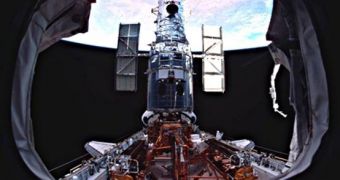With the success of the Discovery mission to the ISS, NASA now has a clear path to begin focusing its efforts on the STS-125 mission, the fifth excursion to the Hubble Space Telescope. During this flight, which will be performed by the space shuttle Atlantis, astronauts will perform five spacewalks, in which they will repair two of the observatory's damaged instruments, and also install two new ones.
Other minor repairs will also be conducted, and the team will install a docking bay. This one will come in handy when the telescope is decommissioned, and forced into the atmosphere by an unmanned spacecraft. Standing-by to aid the effort will also be the shuttle Endeavor, ready to move to orbit if something goes wrong with the Atlantis mission.
The STS-125 crew is scheduled for lift-off on May 12, and will remain in space for approximately 11 days, during which time all the repairs need to be completed. “I think the only thing that beats a beautiful orbiter landing like this is the next launch,. So we're looking forward to that as well,” said on Saturday the deputy shuttle program manager for the American space agency, Leroy Cain, after Discovery safely touched down at the Kennedy Space Center, in Cape Canaveral, Florida.
One of the main threats facing the Atlantis mission is the risk of collision with space debris, that has been calculated by NASA engineers as being somewhere around 1-in-185. Normally, Mission Control does not allow the spacecrafts to fly in areas where the risk is higher than 1-in-200, but this flight will be an exception, on account of the fact that Hubble is orbiting the Earth in a very odd orbit, that doesn't leave too much room for choice on the matter.
Also, because of the recent collision between a Soviet-era satellite and an operational American one, the risk of the shuttle colliding with small metal debris, traveling at speeds of several thousands of miles per hour may increase considerably, experts fear. Some of the space junk may be very small, which makes them all the more dangerous, seeing how a craft as impressive as the shuttle cannot maneuver with the ease of an airplane, as it does not benefit from the support of an atmosphere to move in.
Because Hubble currently moves on an orbit that is both higher and very different from that of the International Space Station, the astronauts aboard Atlantis will have nowhere to go in case a malfunction occurs, or if their heat shield is damaged while exiting the atmosphere. That's why NASA opted for a back-up solution, and has commissioned the shuttle Endeavor to assist its sister ship. That is to say, if something is to malfunction on Atlantis, the other craft will be scrambled to assist.
The crew on STS-125 can survive up to two weeks in space with the provisions they carry, so NASA command announced that, if a rescue mission was to be mounted, Endeavor would lift-off about a week after it received a potential distress call. The time frame will give engineers the opportunity to double- and triple-check the rescue mission's ship, so as to avoid the potential situation in which both shuttles remain stranded in outer space.

 14 DAY TRIAL //
14 DAY TRIAL //